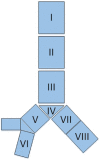Current treatment of tracheoesophageal fistula
- PMID: 28391759
- PMCID: PMC5933624
- DOI: 10.1177/1753465816687518
Current treatment of tracheoesophageal fistula
Abstract
Tracheoesophageal fistulas (TEFs) often occur with esophageal or bronchial carcinoma. Currently, we rely on implantation of delicate devices, such as self-expanding and silicone stents, in the esophagus or trachea to cover the fistula and expand the stenosis in order to relieve patient pain. However, because each case is different, our approach may not be effective for every patient. Consequently, new devices and technology have emerged to address these situations, such as degradable stents, Amplatzer® devices, endobronchial one-way umbrella-shaped valves, and transplantation of mesenchymal stem cells. Although some studies have shown such alternatives can be reasonable solutions in special cases, further development of other new and effectual techniques is of utmost importance.
Keywords: covered self-expanding stents; silicone stents; tracheoesophageal fistula.
Conflict of interest statement
Figures



Similar articles
-
Role of covered esophageal stents in malignant esophagorespiratory fistula.Ann Thorac Surg. 1995 Jul;60(1):199-200. doi: 10.1016/s0003-4975(95)00036-4. Ann Thorac Surg. 1995. PMID: 7598595
-
Tracheoesophageal fistula caused by a self-expanding esophageal stent.Ann Thorac Surg. 1999 Mar;67(3):830-1. doi: 10.1016/s0003-4975(98)01341-1. Ann Thorac Surg. 1999. PMID: 10215238
-
Airway Covered Metallic Stent Based on Different Fistula Location and Size in Malignant Tracheoesophageal Fistula.Am J Med Sci. 2015 Nov;350(5):364-8. doi: 10.1097/MAJ.0000000000000565. Am J Med Sci. 2015. PMID: 26422803
-
[Interventional treatment of tracheoesophageal/bronchoesophageal fistulas].Chirurg. 2019 Sep;90(9):710-721. doi: 10.1007/s00104-019-0988-z. Chirurg. 2019. PMID: 31240352 Review. German.
-
Treatment of malignant tracheoesophageal fistula.Thorac Surg Clin. 2014 Feb;24(1):117-127. doi: 10.1016/j.thorsurg.2013.09.006. Epub 2013 Nov 9. Thorac Surg Clin. 2014. PMID: 24295667 Review.
Cited by
-
Self-Expandable Metal Stent in the Management of Malignant Airway Disorders.Front Med (Lausanne). 2022 Jul 7;9:902488. doi: 10.3389/fmed.2022.902488. eCollection 2022. Front Med (Lausanne). 2022. PMID: 35872800 Free PMC article.
-
Radiation Toxicity in MDA5+ and PL7-Positive Dermatomyositis: Heightened Risk in Autoimmune Subtypes.Int J Part Ther. 2024 Jun 20;14:100109. doi: 10.1016/j.ijpt.2024.100109. eCollection 2024 Dec. Int J Part Ther. 2024. PMID: 39431283 Free PMC article.
-
Local injection of platelet-rich plasma offers a new therapeutic option for the treatment of esophagotracheal fistula: a case report.J Int Med Res. 2024 Jan;52(1):3000605231220874. doi: 10.1177/03000605231220874. J Int Med Res. 2024. PMID: 38179697 Free PMC article.
-
Efficacy and risk factors of stent placement in the treatment of malignant tracheoesophageal fistula.Front Oncol. 2024 Aug 6;14:1421020. doi: 10.3389/fonc.2024.1421020. eCollection 2024. Front Oncol. 2024. PMID: 39165687 Free PMC article.
-
Interventional Pulmonology: A Brave New World.Thorac Surg Clin. 2020 Aug;30(3):321-338. doi: 10.1016/j.thorsurg.2020.04.001. Thorac Surg Clin. 2020. PMID: 32593365 Free PMC article. Review.
References
-
- Martini N, Goodner JT, D’Angio GJ, et al. Tracheoesophageal fistula due to cancer. J Thorac Cardiovasc Surg 1970; 59: 319–324. - PubMed
-
- Morgan RA, Ellul JP, Denton ER, et al. Malignant esophageal fistulas and perforations: management with plastic-covered metallic endoprostheses. Radiology 1997; 204: 527–532. - PubMed
-
- Shin JH, Song HY, Ko GY, et al. Esophagorespiratory fistula: long-term results of palliative treatment with covered expandable metallic stents in 61 patients. Radiology 2004; 232: 252–259. - PubMed
-
- Balazs A, Kupcsulik PK, Galambos Z. Esophagorespiratory fistulas of tumorous origin: non-operative management of 264 cases in a 20-year period. Eur J Cardiothorac Surg 2008; 34: 1103–1107. - PubMed
Publication types
MeSH terms
LinkOut - more resources
Full Text Sources
Other Literature Sources
Medical

